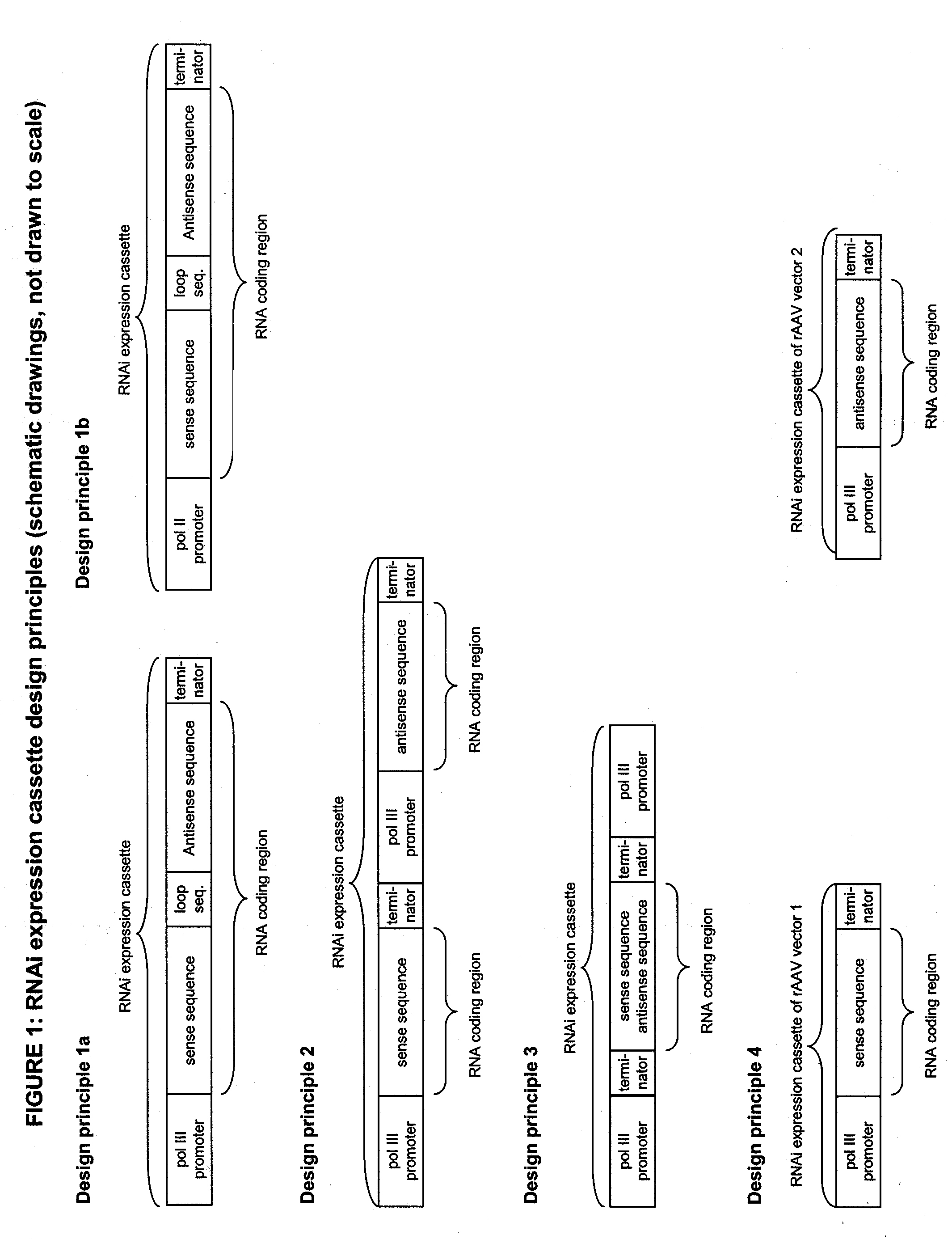DECREASING GENE EXPRESSION IN A MAMMALIAN SUBJECT IN VIVO VIA AAV-MEDIATED RNAi EXPRESSION CASSETTE TRANSFER
- Summary
- Abstract
- Description
- Claims
- Application Information
AI Technical Summary
Benefits of technology
Problems solved by technology
Method used
Image
Examples
experiment 1
[0376] Study Design
Group 1 (5 animals)10.exp.11 genomic particles of AAV2 / 5 U6 lucRI-1aGroup 2 (5 animals)10.exp.11 genomic particles of AAV 2 / 5 RSVlucRI-1bGroup 3 (5 animals)10.exp.11 genomic particles of AAV 2 / 5 U6 / U6lucRI-2Group 4 (5 animals)10.exp.11 genomic particles of AAV 2 / 5 U6 / U6lucRI-3Group 5 (5 animals)10.exp.11 genomic particles of AAV 2 / 5 U6 lucRI-4(sense) and 10.exp.11 genomic particles ofAAV 2 / 5 U6 lucRI-4(antisense)Group 6 (5 animals)10.exp.11 particles of AAV2 / 5 pol1 lucRIGroup 7 (5 animals)10.exp.11 particles of AAV2 / 5 U6 eGFPRI-1aGroup 8 (5 animals)PBS injections
[0377] At day 60, the muscles were harvested, protein extracted and the luciferase activity determined according to manufacturer's instructions (Promega, Madison, Wis. (USA): Luciferase Assay System with Reporter Lysis Buffer #4030). The following results were obtained, expressed as luciferase activity relative to group 8 (PBS injections):
[0378] Experiment 1: Results
Group 114% luciferase activity (+ / −3...
experiment 2
[0384] Study Design
Group 1 (5 animals)10.exp.11 genomic particles of AAV2 / 5 U6 lucRI-1aGroup 2 (5 animals)10.exp.11 particles of AAV2 / 5 U6 eGFPRI-1aGroup 3 (5 animals)PBS control
[0385] At day 60, the lungs were harvested, protein extracted and the luciferase activity determined according to manufacturer's instructions (Promega, Madison, Wis. (USA): Luciferase Assay System with Reporter Lysis Buffer #4030). The following results were obtained, expressed as luciferase activity relative to group 3 (PBS instillation):
[0386] Experiment 2: Results
Group 127% luciferase activity (+ / −5% within 95% confidence interval)Group 298% luciferase activity (+ / −3% within 95% confidence interval)Group 3100% luciferase activity
[0387] Thus, the luciferase-specific RNA interference vector AAV2 / 5 U6 lucRI-1a was capable of significantly decreasing luciferase expression in lung of a mammalian subject via AAV-mediated RNAi expression cassette transfer in vivo compared to an untreated control group (group...
experiment 3
[0391] Study Design
Group 1 (5 animals)10.exp.12 genomic particles of AAV2 / 5 U6 lucRI-1aGroup 1 (5 animals)10.exp.12 particles of AAV2 / 5 U6 eGFPRI-1aGroup 3 (5 animals)PBS control
[0392] At day 60, the livers were harvested, protein extracted and the luciferase activity determined according to manufacturer's instructions (Promega, Madison, Wis. (USA): Luciferase Assay System with Reporter Lysis Buffer #4030)). The following results were obtained, expressed as luciferase activity relative to group 3 (PBS injection):
[0393] Experiment 3
Group 148% luciferase activity (+ / −9% within 95% confidence interval)Group 299% luciferase activity (+ / −5% within 95% confidence interval)Group 300% luciferase activity
[0394] Thus, the luciferase-specific RNA interference vector AAV2 / 5 U6 lucRI-1a was capable of significantly decreasing luciferase expression in liver of a mammalian subject via AAV-mediated RNAi expression cassette transfer in vivo compared to an untreated control group (group 3). The d...
PUM
| Property | Measurement | Unit |
|---|---|---|
| Fraction | aaaaa | aaaaa |
| Fraction | aaaaa | aaaaa |
| Length | aaaaa | aaaaa |
Abstract
Description
Claims
Application Information
 Login to View More
Login to View More - R&D
- Intellectual Property
- Life Sciences
- Materials
- Tech Scout
- Unparalleled Data Quality
- Higher Quality Content
- 60% Fewer Hallucinations
Browse by: Latest US Patents, China's latest patents, Technical Efficacy Thesaurus, Application Domain, Technology Topic, Popular Technical Reports.
© 2025 PatSnap. All rights reserved.Legal|Privacy policy|Modern Slavery Act Transparency Statement|Sitemap|About US| Contact US: help@patsnap.com

